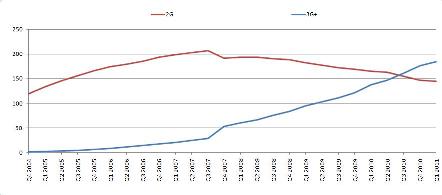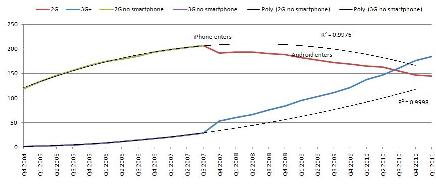He deserves an apple
There have been innumerable paeans to Steve Jobs this week. Reality distortion fields or not, Mr. Jobs has been one of the most influential designers and marketers of information technology products, teaching us how we might redefine the limits of technology. One only needs to look at the long lines around Apple stores, real and fake, to recognize the fervor his company’s products generate.
Bump and slide
A few months ago, with the excellent data sets from Wireless Intelligence in hand, I made a graph of 2G versus 3G+ subscription rates in North America for a document I was working on. This is what I found [graph shows total subscription numbers].

Not only did I find proof for my argument—that 3G subscriptions had long overtaken 2G—but noticed this sudden spike in late 2007 which seems to have accelerated 3G adoption greatly. Thinking that it is more than a coincidince and with the benefit of hindsight, I am willing to say that the spike was the result of the introduction of the iPhone in late 2007.
I want it, so I need it
I did some simple chart manipulation that suggests that 3G would have grown slower at its earlier rates absent the iPhone (the black trendlines). And the Android system also helped, of course, accelerating the shift albeit not as dramatically.
Here, in one graph, is the Steve Jobs effect [graph shows total subscription numbers].

Policy lessons from the smartpone
No doubt, the iPhone and the whole range of interactive, touchscreen driven, apps-loaded smartphones made by HTC, Motorola, and RIM that followed have changed the way we think about mobile devices. In the U.S. and Western Europe, more than a third of mobile subscribers use smartphones.
The trend is not restricted to the developed world. As of mid 2011, over 15 percent of global mobile users are on smartphones. Wireless Intelligence points out one exciting example: the “rapid adoption of smartphones is driving a mobile Internet boom in Vietnam, only 18 months since the country's operators switched on their first 3G networks.” They find that “3G connections in Vietnam surpassed 20 million in Q2 2011, representing around 18 percent of the total base. This has been achieved despite carriers operating in a price-sensitive market where the vast majority of subscribers (over 85 percent) are prepaid."
It seems like people anywhere will want and use technology, even if it is a bit more expensive and seemingly ‘high-end’, if it gives them what they want. Just as inexpensive mobile phones from Nokia in the 1990s proved that mobile telephones were mass market, the iPhone and its successors have begun to show that mobile broadband, multimedia, and the interactive user experience is also for everyone.
This bodes well for the future. Not too long ago, Yongsoo Kim, Tim Kelly, and I had written in our book on broadband that governments looking to drive the growth of their broadband markets should pay close attention to the demand-side—how people access and use broadband services. One of the most important considerations is to make broadband useful and relevant to its possible users. Sometimes, you do that by helping businesses get online, digitizing education, getting PCs into libraries, and localizing content.
And sometimes you do that by dreaming of a device that looks like it came from the future and which lets you shoot birds at pesky pigs. Prometheus would have been proud.
Here's wishing Mr. Jobs the very best.


Join the Conversation